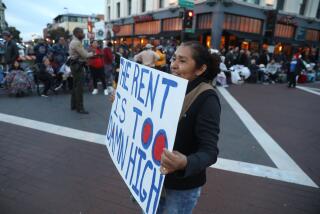Wealth Distribution Back on Front Burner : Now a Fed study agrees: Middle class stagnated in the ‘80s
- Share via
Thomas Paine’s “Common Sense,” Harriet Beecher Stowe’s “Uncle Tom’s Cabin,” Jacob Riis’ “How the Other Half Lives”--from time to time, in American life, a book touches off a major national debate. During spring and summer, 1990, Kevin Phillips’ “The Politics of Rich and Poor” bade fair to join that list. Phillips, the conservative political analyst who predicted the emergence of the new Republican coalition, startled liberals and conservatives alike with his claim that the fruit of Reaganomics was an enormous concentration of wealth at the very top of American society.
In the end, however, that Great Debate was aborted by Saddam Hussein. George Bush’s tax hike (a.k.a. the Omnibus Budget Reconciliation Act of late October, 1990) may owe a little something to Phillips. On the whole, however, rich and poor were burying their differences back then; there was a war to be fought.
ECONOMIC AGENDA: Now we may be picking up where we left off. Phillips’ book, however passe in Washington, was described last month in the Wall Street Journal as “a sort of bible to many state-tax officials.” State taxation, long more regressive than federal taxation, is under review in state after state. Minnesota, for example, has voted to increase its tax on family income above $172,120 from 8% to 8.5%, and a further hike to 10% is possible.
In Washington, the phrase of the hour has been domestic agenda ever since Democrat Harris Wofford defeated Republican Dick Thornburgh in a U.S. Senate race in Pennsylvania. But behind any Democrat calling, as Wofford did, for tax-funded health care comes a Republican calling for tax relief. Liberal populism battles conservative populism.
And who wins? When conservative populism can persuade the electorate that looking close and hard at private wealth is divisive, that greedy government is the real problem, conservative populism wins. When liberal populism can persuade the electorate of the contrary proposition, liberal populism wins.
SOCIAL AGENDA: Is the charge that Reaganomics benefited chiefly the wealthy a cheap shot--party politics at its worst? It became a little harder for conservative populism to answer that question in the affirmative Tuesday when the Federal Reserve Board released a study essentially conceding the liberal contention. To be sure, by putting all Americans with a family income above a modest $50,000 in its top group, the study avoids the most eye-popping statistics of economists like Phillips and Ravi Batra, who claims that by 1987 the top 1% of Americans controlled 36% of the nation’s wealth. Still, by attending to wealth, net worth, rather than only to income, the Fed report has quietly conceded a point that could reverberate as middle-class Americans feel the chill of a lingering recession.
Unfortunately, the economic agenda may be trumped again by the social agenda. Campaign letters from Democratic senatorial contenders Barbara Boxer and Dianne Feinstein both begin by talking about Anita Hill, who has become a major entry on the liberal social agenda. The GOP social agenda still runs to such items as “reverse discrimination.” All these things matter, but are candidates using them to avoid talking about whose money is going to whom?
The economic bedrock of American democracy has been a middle class large enough and rich enough to buy what an industrial society produces. Our social compact has called, in other words, for putting most of the nation’s wealth into the hands of people who would spend it. If that compact was broken by the economic policies of the 1980s, the nation has a serious problem. It will take political leadership with intelligence as well as heart to call this question. In 1992, with America confronting no major external enemies, history may not forgive us if we duck it.
More to Read
Get the L.A. Times Politics newsletter
Deeply reported insights into legislation, politics and policy from Sacramento, Washington and beyond. In your inbox twice per week.
You may occasionally receive promotional content from the Los Angeles Times.










